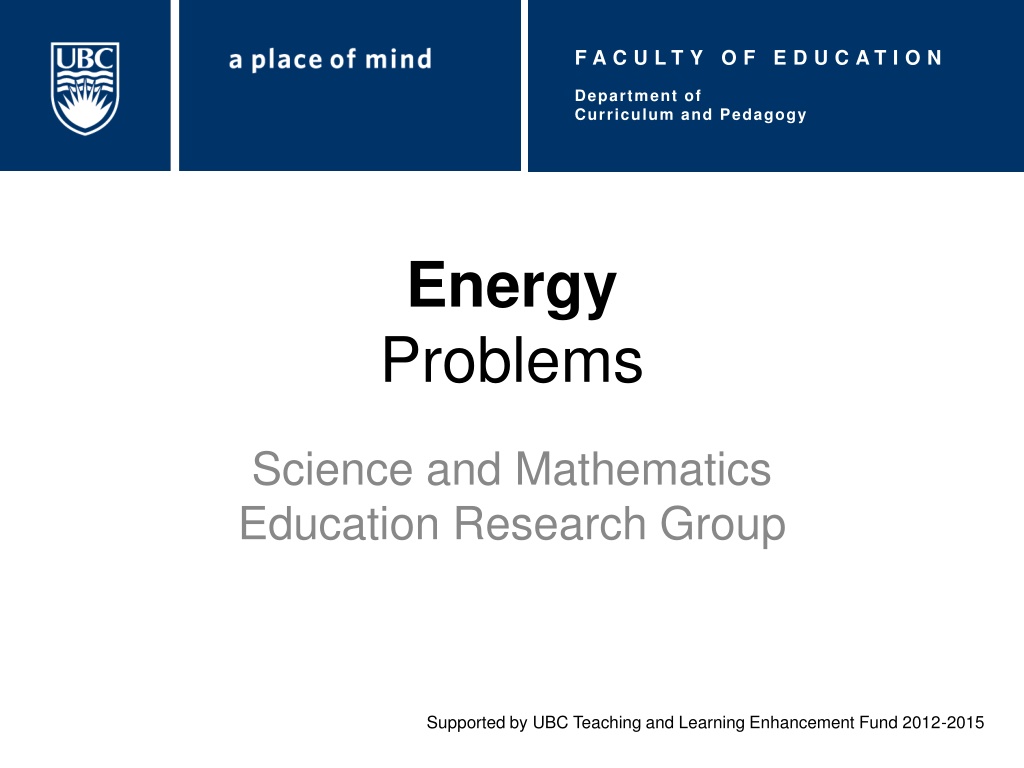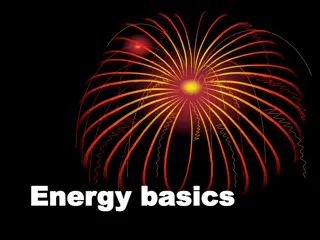Energy Problems in Science Education
The Faculty of Education at UBC is involved in researching energy problems and science education. Questions related to energy and physics concepts are discussed, including topics like kinetic and potential energy, collisions, and conservation of energy. The provided content includes questions, solutions, and explanations to help understand key concepts in energy and physics education.
Uploaded on Oct 02, 2024 | 0 Views
Download Presentation

Please find below an Image/Link to download the presentation.
The content on the website is provided AS IS for your information and personal use only. It may not be sold, licensed, or shared on other websites without obtaining consent from the author. Download presentation by click this link. If you encounter any issues during the download, it is possible that the publisher has removed the file from their server.
E N D
Presentation Transcript
FACULTY OF EDUCATION FACULTY OF EDUCATION F A C U L T Y O F E D U C A T I O N Department of Curriculum and Pedagogy Energy Problems Science and Mathematics Education Research Group Supported by UBC Teaching and Learning Enhancement Fund 2012-2015
Question Title Question Title Energy Problems Retrieved from: http://www.success.co.il/knowledge/images/matter-and-energy-Physics-e=mc2.jpg
Question Title Question Title Energy Problems The following questions have been compiled from a collection of questions submitted on PeerWise (https://peerwise.cs.auckland.ac.nz/) by teacher candidates as part of the EDCP 357 physics methods courses at UBC.
Question Title Question Title Energy Problems I An object is lifted to some height and then dropped. During the drop, which of the following is increased? Neglect air resistance. A. Kinetic energy only B. Gravitational potential energy only C. Kinetic energy and total mechanical energy D. Kinetic energy and gravitational potential energy E. None of the above
Question Title Question Title Solution Answer: A Justification: Total mechanical energy is the sum of all energy. In this question, it is the sum of kinetic and potential energies because the air resistance is neglected. Due to the conservation of energy, the sum of kinetic and potential energies is the same throughout the drop of the object. As the object falls down, its velocity increases due to gravity. So, its kinetic energy increases. On the other hand, its height from the ground decreases so the potential energy decreases. Overall, the sums of kinetic and potential energies at any height during the drop are the same. Therefore, the total mechanical energy stays the same, the kinetic energy increases and the gravitational potential energy decreases. Thus, the answer is kinetic energy only which is option A.
Question Title Question Title Energy Problems II Which of the following statements is TRUE? A. In an elastic collision kinetic energy is conserved but momentum of the system is not B. In an inelastic collision kinetic energy is conserved but momentum of the system is not C. In an elastic collision kinetic energy is lost through temporary deformation of the objects D. In an inelastic collision kinetic energy is lost but momentum of the system is conserved E. In either type of collision kinetic energy is always conserved
Question Title Question Title Solution Answer: D Justification: The concepts involved in this question are: 1) In an elastic collision kinetic energy is conserved due to the temporary deformation of the objects. This occurs in cases such as billiard ball collisions during a pool game, as seen here:
Question Title Question Title Solution continued 2) In an inelastic collision total energy is still conserved but some kinetic energy is lost and transformed into energy in the form of sound, thermal energy, or permanent deformation of the objects. An example of this is can be observed in the case of a car collision, where there is a large sound and the car body is deformed upon impact. 3) Momentum is conserved in both elastic and inelastic collisions. A) Incorrect - disagrees with statement 3 B) Incorrect - disagrees with statements 2 and 3 C) Incorrect - disagrees with statement 1 D) Correct - agrees with statements 2 and 3 E) Incorrect - disagrees with statement 2
Question Title Question Title Energy Problems III A block of mass m is released from rest at the top of a semi- circular frictionless track of radius R.
Energy Problems III Question Title Question Title continued Which of the following expressions most accurately represents the speed of the block at the bottom of the track? g is the acceleration due to gravity.
Question Title Question Title Solution Answer: B Justification: To solve this problem we need to use the conservation of energy. At the top of the track, the block has potential energy of: Since it is stationary at the top of the track, it has no kinetic energy and therefore the total mechanical energy of the block is equal to EP. At the bottom of the track, the block has kinetic energy of: Since we have used the bottom of the track to represent ground zero, the block has no potential energy at this point, and therefore the total mechanical energy of the block is equal to EK. Since the track is frictionless, the only energies we are dealing with are Kinetic and Potential energy. Therefore no energy is lost due to heat or friction, so the total mechanical energy will be the same at the top and bottom of the track.
Question Title Question Title Solution continued Therefore: (answer B)
Question Title Question Title Energy Problems IV A 50kg ski jumper skis down a frictionless slope as shown below. The skier is stationary at point 1.
Energy Problems IV Question Title Question Title continued At which point is the following true? A. 1 B. 2 C. 3 D. 4 E. Both 2 and 4
Question Title Question Title Solution Answer: E Justification:This problem can be solved numerically by calculating the gravitational potential energy at each of the five points using: For the numbers 1 through 5 we would get the EPto be 50kJ, 30kJ, 15kJ, 30kJ, and 0kJ respectively. Since we know that at point 1, the skier has no velocity (and therefore no kinetic energy EK), then the total mechanical energy is equal to EP at that point (50kJ). Due to the lack of friction, we know that the total mechanical energy will be equal at all points of the skier s trajectory, and that no energy will be converted into heat due to friction. Therefore we can calculate EK at points 1 through 5 by subtracting EP from the total mechanical energy and so we get EK to be 0kJ, 20kJ, 35kJ, 20kJ, and 50kJ respectively.
Question Title Question Title Solution continued From there we can calculate the ratios between EPand EK, and we will find that at points 2 and 4 (answer E). However, this question is easier to solve if we see that neither potential nor kinetic energy can be zero. Therefore we can rule out point 1 (answer A), since EK is zero at this point. We can also see that for the ratio to hold true, EP > EK, and therefore the skier must still be more than halfway up the slope. Therefore we can rule out answer C. Since points 2 and 4 are on the same elevation (60m), the answer must be E.
Question Title Question Title Energy Problems V A total radical skater dude is doing sweet tricks on an epic (frictionless) skate track. Y 0 0 X
Energy Problems V Question Title Question Title continued If he starts from rest at point 1, which graph represents his EP and EK best at point 2? A. B. E. C. D.
Question Title Question Title Solution Answer: C Justification: As the skater descends the track, his initial potential energy is converted without loss (no friction) into kinetic energy. As point 2 is the lowest point on the track, the skater will have maximum kinetic energy at this point, so you may be tempted to select option D, which shows 0% potential energy, and 100% kinetic energy. However, point 2 is not at ground level, which is the point of reference for calculating potential energy (using the axes provided), and so the skater will still have some potential energy. Thus, D is incorrect. As the skater is clearly closer to the ground than to the top of the track, his EK will be greater than his EP, so A and B are incorrect. He is also very obviously not at the top of the track, so he will have at least some EK, so E is also incorrect. Thus, C must be the right answer, with EK > EP, but EP > 0.
Question Title Question Title Energy Problems VI An ice cube of mass m is placed on the rim of a hemispherical glass bowl of radius r and then released to slide inside it. v is the tangential velocity of the ice cube at the bottom of the bowl, and aR is its radial acceleration. r aR v
Energy Problems VI Question Title Question Title continued What are v2 and aR of the ice cube as it reaches the bottom of the bowl (point 1)? g is the acceleration due to gravity. A. v2 = gr and aR = g B. v2 = 2gr and aR = 2g C. v2 = gr and aR = mg D. v2 = 2gr and aR = 2mg E. v2 = gr and aR = g
Question Title Question Title Solution Answer: B Justification: To solve this question we can use the conservation of mechanical energy (here we are assuming there is no friction between the block of ice and the bowl). At the rim of the bowl, the ice cube posses only potential energy (EP), and no kinetic energy (EK). If we take the bottom of the bowl to be our zero ground, then at the bottom of the bowl the ice cube posses only EK andno EP. Therefore the potential energy of the ice cube at the bowl rim is entirely converted to kinetic energy at the bottom. We can express this using formulas:
Question Title Question Title Solution continued To solve for the radial acceleration, we use the following formula: Therefore the answer is v2 = 2gr and aR = 2g (answer B) Notice here that we did not need to make use of the mass of the ice block (m). In fact, we could have easily ruled out options C and D by realizing that the units for aR are in kg.m/s2, which is the unit for force, and not acceleration.
Question Title Question Title Energy Problems VII A marble was released at height h and it gained a final velocity of v at the bottom of the frictionless slide. If the same marble in the diagram below is released from rest at h, what would be its new final velocity in terms of v at the bottom of the slide? h
Question Title Question Title Solution Answer: C Justification: To solve this question we can use the conservation of mechanical energy (the slide is frictionless and therefore no energy is converted into heat energy). Situation 1: At the top of the slide, the marble posses only potential energy (EP), and no kinetic energy (EK). If we take the bottom of the slide to be our zero ground, then at the bottom of the slide the marble posses only EK andno EP. Therefore the potential energy of the marble at the top of the slide is entirely converted to kinetic energy at the bottom. We can express this using formulas:
Question Title Question Title Solution continued Now we can look at the situation where the marble starts halfway down the slide (at h). In this case we will also get conservation of mechanical energy: Since we know that the original velocity v = 2gh, we can express the new velocity v2 in terms of v: Therefore: (answer C)
Question Title Question Title Energy Problems VIII A 9.000 g bullet is shot into a 5.000 x 10-1 kg crate hanging on the wall. As a result, the crate swings up a maximum height of 1.000 m with the bullet embedded inside the crate.
Energy Problems VIII Question Title Question Title continued Which of the following statements is FALSE? A. The bullet has a kinetic energy of 1125 J. B. The tension in the string did 0 J of work. C. All the bullet's kinetic energy was converted into the gravitational potential energy. D. Some of the bullet's kinetic energy was converted into heat energy as the crate stopped the bullet.
Question Title Question Title Solution Answer: C Justification: If we take the initial height of the bullet and crate as the zero ground, then we can say that the potential energy (EP) of the system was zero before the bullet hit the crate. Since the crate was stationary, the only energy of the system before the collision was the kinetic energy (EK) of the bullet. We can calculate this energy: Note: Don t forget to convert the 9.000 g into 0.009 kg Therefore the total energy of the system before the collision is 1125 J. After the collision, the crate reaches a height of 1.000 m. At the height of the swing, both the crate and the bullet are stationary, therefore they do not possess any kinetic energy. Therefore the total mechanical energy of the system can be represented by the potential energy of the crate and bullet at the maximum height of the swing.
Question Title Question Title Solution continued We can calculate this potential energy: Note: Don t forget to add the mass of the crate and bullet together Therefore the total mechanical energy (potential plus kinetic) of the system after the collision is only 4.988 J. But we know that the bullet supplied a kinetic energy of 1125 J to the system, therefore the rest of the energy must have been converted into heat energy or energy of deformation as the bullet struck the crate. Now we can look at the answers individually and see which ones are true and false (remember that we are looking for the false answer): A) This is true as we have calculated it (Ekbullet = 1125 J) B) Since the tension in the string is perpendicular to the motion of the crate, it has no component in the direction of the crate s motion and therefore did 0 J of work. Therefore this answer is true.
Question Title Question Title Solution continued 2 C) Since we know that a large proportion of the kinetic energy of the bullet was lost during the collision, we know that not all of the bullet s kinetic energy was converted to gravitational potential energy. Therefore this answer is false. D) We know that a large amount of the bullet s initial kinetic energy was converted to other forms of energy during the collision, therefore this answer is true. Since C is the only answer which is false, it is the correct answer.
Question Title Question Title Energy Problems IX A 9.000 g bullet is shot into a 5.000 x 10-1 kg crate hanging on the wall. As a result, the crate swings up a maximum height of 1.000 m with the bullet embedded inside the crate.
Energy Problems IX Question Title Question Title continued If all the lost kinetic energy was converted into thermal energy heating up the wooded crate, what is the final temperature of the wood crate if it was initially at room temperature (20.00 C)? The specific heat capacity of wood is 1700 J.kg-1. C-1. The acceleration due to gravity is 9.8 m/s2. A. 20.00 C B. 21.26 C C. 21.29 C D. 21.32 C
Question Title Question Title Solution Answer: D Justification: If we take the initial height of the bullet and crate as the zero ground, then we can say that the potential energy (EP) of the system was zero before the bullet hit the crate. Since the crate was stationary, the only energy of the system before the collision was the kinetic energy (EK) of the bullet. We can calculate this energy: Note: Don t forget to convert the 9.000 g into 0.009 kg Therefore the total energy of the system before the collision is 1125 J. After the collision, the crate reaches a height of 1.000 m. At the height of the swing, both the crate and the bullet are stationary, therefore they do not possess any kinetic energy. Therefore the total mechanical energy of the system can be represented by the potential energy of the crate and bullet at the maximum height of the swing.
Question Title Question Title Solution continued We can calculate this potential energy: Note: Don t forget to add the mass of the crate and bullet together Therefore the total mechanical energy (potential plus kinetic) of the system after the collision is only 4.988 J. But we know that the bullet supplied a kinetic energy of 1125 J to the system, therefore the rest of the energy must have been converted into heat energy: We can now use this to calculate by how much the temperature of the crate increased. To do this we will use the formula for heat capacity: Q = mc T, where Q is the heat energy, m is the mass of the crate, c is the specific heat capacity of wood, and T is the change in temperature
Question Title Question Title Solution continued 2 We know the initial temperature of the crate (20.00 C), therefore: Therefore the correct answer is D
Question Title Question Title Energy Problems X A ball is fixed to the end of a string, which is attached to the ceiling at point P. As the drawing shows, the ball is projected downward at A with the launch speed v0. Traveling on a circular path, the ball comes to a halt at point B.
Energy Problems X Question Title Question Title continued What enables the ball to reach point B, which is above point A? Ignore friction and air resistance. A. The work done by the tension in the string. B. The ball's initial gravitational potential energy. C. The ball's initial kinetic energy. D. The work done by the gravitational force.
Question Title Question Title Solution Answer: C Justification: This is a conservation of energy question. Since point B is above point A, the ball will have a greater gravitational potential energy at point B than point A. Therefore in order for energy to be conserved, the ball must have had some kinetic energy at point A (for example giving the ball a push), so that it will have the energy to reach point B. If we look at all the possible answers: A) The work done by the tension in the string is zero because the tension force is perpendicular to the motion of the ball. Therefore this answer is incorrect. B) Without an input of other energy, the ball does not have enough gravitational potential energy at point A to reach point B if it was just let go. Therefore this answer is incorrect.
Question Title Question Title Solution continued C) If you give the ball a push at point A instead of letting it go you would give it more kinetic energy, which will be converted into gravitational potential energy at point B. Therefore this answer is correct. D) While the gravitational force would help the ball accelerate downwards, this will not necessarily help it reach point B since we know that at point B the ball will have more gravitational potential energy than at point A. Without giving the ball extra energy, the ball would only be able to reach the same height as it was at point A. Therefore this answer is incorrect.
Question Title Question Title Energy Problems XI A moving body of mass m collides with a stationary body of double the mass, 2m, sticks to it and continues moving. What fraction of the original kinetic energy is lost? 2m 2m m m A. 1/4 B. 1/3 C. 1/2 D. 2/3 E. 3/4
Question Title Question Title Solution Answer: D Justification: For this question we will need to use conservation of momentum to help determine how much kinetic energy was lost in the collision (this is an inelastic collision since kinetic energy was lost to heat/deformation/etc.). Let us draw the picture again and add in all the values we need: BEFORE AFTER v2 2m 2m v1 m m
Question Title Question Title Solution continued Initially, the kinetic energy of the system is: After the collision, the two bodies move as one with a speed of v2. Conservation of momentum would determine that: Therefore the kinetic energy of the system after the collision is: So the lost kinetic energy is:
Question Title Question Title Solution continued 2 Finally, we need to calculate the fraction of the original kinetic energy that was lost. We do this by dividing the amount that was lost by the original amount: (answer D) Most collisions are inelastic because kinetic energy is transferred to other forms of energy such as thermal energy, potential energy, and sound during the collision process. A perfectly inelastic collision is one in which the maximum amount of kinetic energy has been lost during a collision, making it the most extreme case of an inelastic collision. In most cases, you can tell a perfectly inelastic collision because the objects in the collision "stick" together, sort of like a tackle in American football.
Question Title Question Title Energy Problems XII h h 0 ground level
Energy Problems XII Question Title Question Title continued The speeds of the rollercoaster cart at height h, h and at ground level can best be described by the ratio: A. 1:2:3 Note: Choose the best answer for the ratio of h: h:ground level B. 1:4:9 C. 3:2:1 D. 9:4:1 E. 10:14:17
Question Title Question Title Solution Answer: E Justification: For this question we will need to use conservation of mechanical energy (the rollercoaster is frictionless so there is no energy converted to heat energy). We can look at each different height of the rollercoaster separately and find out what the speed of the cart is at each level. 1) At height h: We know that at this height the speed of the cart We can also find out the total mechanical energy (kinetic plus potential) of the cart:
Question Title Question Title Solution continued 2) At height h: First we need to find out the total mechanical energy (kinetic plus potential) of the cart at h: Since total mechanical energy is conserved, we know that the total mechanical energy at height h is the same as at height h:
Question Title Question Title Solution continued 2 3) At height 0 (ground level): First we need to find out the total mechanical energy (kinetic plus potential) of the cart at ground level: Since total mechanical energy is conserved, we know that the total mechanical energy at height h is the same as at ground level:
Question Title Question Title Solution continued 2 Now we can compare the ratios of the speeds at h, h and ground level: 1 : 1,4 : 1,7 This ratio expressed to the nearest integer ratio is 10:14 :17 Therefore the correct answer is E.























